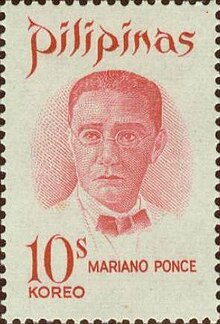Mariano Ponce
Mariano Ponce | |
|---|---|
 Ponce c. 1900s (On a PPC 1970 stamp) | |
| Member of the Philippine Assembly from Bulacan's 2nd district | |
| In office 1909–1912 | |
| Preceded by | León María Guerrero |
| Succeeded by | Ceferino de León |
| Personal details | |
| Born | Mariano Ponce y Collantes March 22, 1863 Baliwag, Bulacan, Captaincy General of the Philippines, Spanish Empire |
| Died | May 23, 1918 (aged 55) Government Civil Hospital, Sai Ying Pun, British Hong Kong, British Empire |
| Resting place | Baliuag Catholic Cemetery |
| Political party | Nacionalista |
| Spouse | Okiyo Udanwara |
| Children | 4 |
| Parents |
|
| Education | Colegio de San Juan de Letran University of Santo Tomas Universidad Central de Madrid |
| Occupation | Physician, writer, politician |
| Known for | Philippine Revolution, La Solidaridad, Propaganda Movement |
| Nickname(s) | Naning, Kalipulako, Tikbalang |
Mariano Ponce y Collantes (Spanish: [maɾjˈano pˈonθe]; March 22, 1863 – May 23, 1918) commonly known as just Mariano Ponce was a Filipino physician, writer, statesman, and active member of the Propaganda Movement. In Spain, he was among the founders of La Solidaridad and Asociación Hispano-Filipino. Among his significant works was Efemerides Filipinas, a column on historical events in the Philippines which appeared in La Oceania Española (1892–1893) and El Ideal (1911–1912). He wrote Ang Wika at Lahi (1917), a discussion on the importance of a national language. He also served as Bulacan's representative to the Philippine Assembly from 1909 to 1912.
Biography
[edit]
Ponce was born in Baliuag, Bulacan to Mariano Ponce and Maria Collantes. He had six siblings: Vicente, Fransisco, Jacinto, Carmen, Pedro, and Consolacion Ponce. He also completed his primary education in Baliuag. He completed his secondary education at the private school of Juan Evangelista, Hugo Ilagan, and Escolastico Salandanan in Manila. He later enrolled at the Colegio de San Juan de Letran and took up medicine at the University of Santo Tomas. In 1881, he traveled to Spain to continue his medical studies at the Universidad Central de Madrid.
There he joined Marcelo H. del Pilar, Graciano López Jaena, José Rizal and others in the Propaganda Movement. This espoused Filipino representation in the Spanish Cortes and reforms in the Spanish colonial administration of the Philippines. Ponce was the co-founder of La Solidaridad with fellow co-founder Graciano López Jaena. He was also the head of the Literary Section of the Asociacion Hispano-Filipina, created to aid the Propaganda Movement where he served as secretary.[2]
In La Solidaridad, his works included daily editorials on history, politics, sociology and travel. Ponce used several pen names, including "Naning", his nickname; "Kalipulako", named after Lapu-Lapu; and "Tigbalang", a supernatural being in Filipino folklore.[3]

Ponce was imprisoned when the revolution broke out in August 1896 and was imprisoned for forty eight hours before being released. Fearing another arrest, he fled to France and later went to Hong Kong where he joined a group of Filipinos and Chinese Filipinos, who served as the international front of the Philippine revolution.
In 1898, Emilio Aguinaldo chose him to represent the First Philippine Republic. Ponce was tasked to draft a framework of the revolutionary government. In 1898, Emilio Aguinaldo selected him as a diplomatic representative of the First Republic to Japan. He traveled to Japan to seek aid and purchase weapons. During his stay he met with the founder and First President of the Chinese Republic; Sun Yat-Sen.[4] Through discussions and negotiations, Dr. Sun and Ponce became close friends. Dr. Sun introduced Ponce to a Japanese Filipino man named José Ramos Ishikawa, who assisted Ponce in purchasing weapons and munitions for the revolution. The shipment, unfortunately failed to reach the Philippines due to a typhoon off the coast of Formosa.[3]
Mariano returned to Manila with his wife, a Japanese girl named Okiyo Udanwara (or Udagawa).[5] In 1909, he was made director of "El Renacimiento" (The Renaissance). He joined the "Nacionalista Partido" (National Party) and established "El Ideal" (The Perfect), the party's official organization. Ponce later ran for a seat in the Philippine Assembly and was elected assemblyman for the second district of Bulacan in 1909. He served for one term until 1912.

Ponce wrote his memoirs, "Cartas Sobre La Revolución" (Letters on the Revolution). He died in the Government Civil Hospital in Hong Kong, on May 23, 1918. His remains were originally interred in the Cementerio del Norte, Manila.[1] According to local historian Rolando Villacorte, his remains were transferred to the Art Deco Ponce family mausoleum in Baliuag Catholic Cemetery. There, he is interred alongside his wife, brother Jacinto, daughter Maria, and grandson Marianito Ponce Gonzales.
On May 23, 2019, the National Historical Commission of the Philippines opened the Museo ni Mariano Ponce at the Ponce property in Baliuag, Bulacan.[6]
References
[edit]- ^ a b "Mariano Ponce". Provincial Government of Bulacan. Retrieved June 21, 2023.
- ^ http://www.globalpinoy.com/gp.topics.v1/viewtopic.php?postid=4cf8578e2cc76&channelName=4cf8578e2cc76Mariano Archived June 22, 2015, at the Wayback Machine Ponce: Founder of La Solidaridad
- ^ a b Mariano Ponce: Founder of La Solidaridad
- ^ "Mariano Ponce". Bulacan, Philippines. Retrieved December 11, 2021.
- ^ "Cultural Heritage". Retrieved October 14, 2012
- ^ Sarmiento, Edgar Allan (June 16, 2019). "NHCP opens Museo ni Mariano Ponce". INQUIRER.net. Retrieved August 17, 2020.
External links
[edit]- 1863 births
- 1918 deaths
- People of the Philippine Revolution
- Filipino exiles
- Filipino expatriates in Hong Kong
- Filipino nationalists
- 19th-century Filipino medical doctors
- Filipino writers
- University of Santo Tomas alumni
- Complutense University of Madrid alumni
- Politicians from Bulacan
- Members of the House of Representatives of the Philippines from Bulacan
- Colegio de San Juan de Letran alumni
- Nacionalista Party politicians
- Burials at the Manila North Cemetery
- Members of the Philippine Legislature
- Filipino propagandists
- People from the Spanish East Indies
